TAEKWON-DO HISTORY
(by Master Choong Teck Hong)
It is my intention to write taekwon-do history as it happened so that our future generation would know how taekwon-do developed to its present glory. Should anyone feel that I have erred and what has been written needs to be corrected, I welcome any suggestion.
Master Choong Teck Hong
ANCIENT HISTORY
Ancient murals and statues have shown that taekyon, the ancient Korean art of foot-fighting existed as far back as the 1st. century B.C. Historical evidence in the form of pictures and statues showed the existence of a form of fighting in Korea, resembling the legendary taekyon. Mural paintings at Kak-je tomb, during the 10th.king of Koguryo, shows sparring similar to contestants performing the jumping kicks of taekwon-do. Other than statues and murals there was no documentation to substantiate the existence until the 7th. century when there was evidence of the existence of the division of Korea into 3 kingdoms.
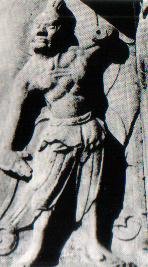
|
The statue of Kumkang-Yuksa, a famous Korean warrior, found in a stone cave in Sukulam. The stone cave was traced back to the Silla Dynasty. Notice the similarity of the stances of statue and the present taekwon-do form.
|
Writings by Korean historians indicated that during the 5th. century A. D. ancient Korea was divided into three kingdoms - Silla, Koguryo and Baek Je. Silla, the smallest of the 3 kingdoms was constantly under the invasion of the other 2 bigger kingdoms. It was during the 37th year of his reign that Chin Heung, the 24th. king of Silla organised the young warriors of Silla and formed the Hwarang do to resist the attacks of Koguryo and Baek Je. This movement is the equivalent to the samurai of Japan. These young aristocrats trained themselves mentally and physically and thus the emergence of a formal form of Taekyon , also known by another name - Soo Bak Gi. There were some records of the existence of Soo Bak Gi.
Korean historian Dr. Danjae Shin Chae Ho described the contests of the art of Soo Bak Gi or Taekyon - the ancient art of foot-fighting during the mid autumn festivals in Korea during the Koguryo Dynasty ( A.D. 500 ). In another study Dr. An Ja San corraborated the study, further stating that the Yoo Sul School of martial arts was known as Soo Bak Gi ( Taekyon ) in his book on ancient Korea. Historical documents documented that the third king of the Yi Dynasty (1401-1408 A.D.) recruited experts in Soo Bak Gi and sirum (Korean style of wrestling) in his army. According to Mr. Song Duk Ki - a veteran of taekyon, by the end of the Yi dynasty (1393 - 1910), the art of taekyon has developed. After the Yi Dynasty, during the Japanese occupation various martial arts were introduced into Korea from Japan and China , enabling the merging of taekyon with these arts, thus the emergence of Tang Soo, Kong Soo, Kwon Po and Tae Soo which are fore-runners of modern taekwon-do.
GEN CHOI HONG HI submitted the name of Taekwon-do to the Naming Committee.It was endorsed by Korean President Rhee Seung Man. MAJOR NAM TAE HI the right hand man of Gen Choi Hong Hi-Instructor from Chung Do Kwan who led the members to join Oh Do Kwan
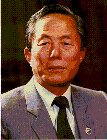
GEN. CHOI HONG HI
|
|

MAJOR NAM TAE HI
|
MODERN HISTORY
After World War II and the Japanese occupation there was a new resurgence of martial arts in Korea. This saw the emergence of various schools of martial arts or kwans. Styles were varied with each teacher teaching their own versions of martial arts. The major kwans during that time were:
* Chung Do Kwan - established by Master Lee Won Kuk. He was teaching Tang Soo Do (the art of the Tang Dynasty )
* Moo Do Kwan - established by Master Hwang Ki . He was also teaching his own version of Tang Soo Do
* Yon Moo Kwan - established by Master Chon San Sop. He taught his art called Kong Soo Do (the art of empty hand). The name was changed to Ji Do Kwan after his disappearance during the Korean War.
* Song Moo Kwan - established by Master Ro Byong Jik, a student of karate who learnt the art with Lee Won Kuk in Japan
* Chang Moo Kwan -established by Master Yun Byong In who taught karate with a mixture of Chinese Chin-ah
* Oh Do Kwan - established by General Choi Hong Hi.
All the kwans were teaching their own form of martial arts. All the Masters received karate training . Although the masters were training martial arts under different names what they taught had a very strong Japanese and Chinese influence, as can be seen by the names and techniques.The first five schools were established in 1946 except Oh Do Kwan which was established only in 1953 but it was with the establishment of Oh Do Kwan that martial arts in Korea revolutionised.
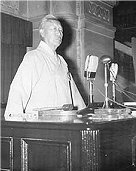
PRESIDENT RHEE SYNG MAN
|
|
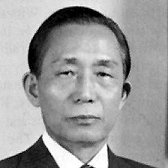
PRESIDENT PARK CHUNG HEE
|
OH DO KWAN AND GENERAL CHOI HONG HI
Choi Hong Hi was a 2nd Lieutenant at the 3rd. Battalion of Yong Dae Base. He was an exponent of Taekyon the Korean art of foot-fighting since his childhood days where he trained under his calligraphist tutor and Taekyon expert, Han Il Dong. In 1937 he left for Japan to further his studies and it was there that he intensified his martial arts where he attained his 2nd.dan in Karate. When World War II broke out he was implicated as the leader of the Korean Independence Movement and was imprisoned in the Japanese prison. With the liberation of Korea in August 1945 Choi's 7 year prison sentence was cut short. In January 1946 he was commissioned as a 2nd. lieutenant in the Korean army. His teaching of martial arts began here in Kwang Ju and later in the 2nd infantry regiment in Tae Jon. This spearheaded the spread of taekwondo. In the year 1952 at the height of the Korean War, Korea held a massive show of patriotism. Included in the agenda was the biggest martial arts display when all the Kwans of Korea displayed their skills. Major Nam Tae Hi stole the show when he smashed 13 roof tiles with a forefist punch. Subsequent to the demonstration, President Rhee Seung Man of Korea instructed General Choi Hong Hi to introduce the martial arts to all the Chief Of Staffs and the Korean army. In 1953 the Korean War ended and Choi organised the 29th. Infantry division at Che Ju island. It was here that he established the Oh Do Kwan - He merged the techniques of taekyon, tang soo do and karate,with the help of Major Nam Tae Hi of Chong Do Kwan - the largest civilian martial arts body in Korea. By the end of 1953 Chong Do Kwan has merged with Oh Do Kwan It was necessary to find a common name acceptable to all kwans of Korea something that has been attempted by others but have failed.
NAMING COMMITTEE
A naming committee was formed. It comprised Major General Choi Hong Hi; General Lee Hyung Kun-the Joint Chief Of Staff of the Korean Army; Cho Kyung Kyu- the Vice Speaker Of Korean Assembly; Senator Chung Dae Chun; Han Chang Won-the President of the Korean Political Newspaper; Sung Duk Sung - the Director of Chung Do Kwan and Chang Kyung Rok, Hong Soon Ho, Ko Kwang Rae and Hyun Jong Myung - the representatives of the 5 major kwans of Korea.( By the 1950s there were about 40 splinter groups and so it was not possible to include such a vast group in the committee).The Naming Committe sat to propose a name to be submitted to President Rhee Seung Man for approval. The name of TAEKWON-DO was eventually accepted because it was meaningful," Tae" means to kick and "Kwon" means to punch. Moreover " taekwon-do " sounds like Taekyon, the ancient art of Korean foot-fighting. Names like tang soo do ( art of the Tang Dynasty ) and kong soo do ( the art of empty hand - karate )which is Chinese and Japanese inclined is dropped.
The name TAEKWON-DO was submitted to President Rhee Seung Man of Korea and it was endorsed by him. Taekwon-do was born - on 11th. April, 1955
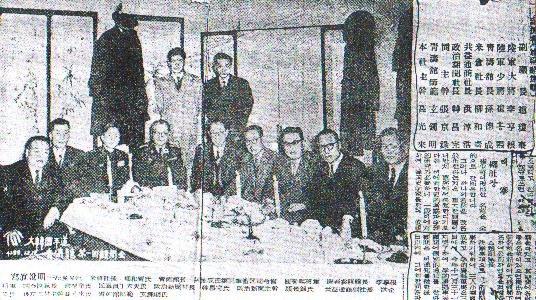
Members Of The Naming Committee Who Proposed The Name TAEKWON-DO & Had It Submitted To President Rhee Seung Man Of Korea For Endorsement Yoo Hwa Chung, Son Duk Song ( Director Of Chung Do Kwan ), Maj. Gen. Choi Hong Hi, Gen. Lee Hyung Kun ( Joint Chiefs Of Staff ), Cho Kyung Kyu ( Vice Speaker), Senator Chung Dae Chun, Han Chang Won ( President Of Political Press), Chang Kyung Rok, Hong Son Ho, Ko Kwang Rae, Hyun Jong Myung
TAEKWON-DO: THE NEW KOREAN MARTIAL ART
In 1955 General Choi spread taekwondo to all universities and military outposts throughout Korea, backed by the military. The military command at Tae Jon was the centre of activity.
In 1959 saw the formation of the Korean Taekwon-do Association where all the kwans came under one roof.General Choi had the support of the Ministry of Education and the Ministry of Sports , which was the official sports governing body in Korea. The members who attended the meeting were:
1. the Director of the Korean Amateur Sports Association
2. the Director of Physical Education from the Ministry of Education
3. General Choi Hong Hi
4. The Kwan Jang of the major kwans - Chung Do Kwan,Oh Do Kwan,Song Moo Kwan, Chang Moo Kwan and Moo Duk Kwan
At this meeting General Choi Hong Hi was elected the 1st. President of Korean Taekwon-do Association ( KTA ). However Hwang Ki, the Kwan Jang of Moo Duk Kwan seceded from KTA and to this day historians named him as the trouble maker. 1959 was also the year when taekwon-do was introduced out of Korea. General Choi Hong Hi and Major Nam Tae Hi, together with 18 of his best taekwon-do instructors toured the Far East, giving demonstrations and opening associations in each country they visited. This new art was a craze.
TAEKWON-DO UNDER OH DO KWAN & CHUNG DO KWAN
The Vietnam war broke out in 1960. Major Nam Tae Hi was among those who were sent to Vietnam on active duty.It was from the army that many of the combat taekwon-do instructors were trained and later dispatched to other countries after they have been released from the army.
However there was a lot of unhappiness in KTA. General Choi was accused of being autocratic and not consulting other kwans in decisions. Black Belt holders from all civilian kwans had to resit for their black belts when they joined the army.Only members from Oh Do Kwan and Nam Tae Hi's Chung Do Kwan were exempted. He was also accused of dispatching instructors without consultation.General Choi held extreme power because of his military position and the backing of the Liberal Party of President Rhee Syn Man. He practically overshadowed all the other masters of other kwans.
1960 was also a year full of events in Asia.Not only did the Vietnam war break out but there was a political upheaval in Korea. General Park Chung Hee planned and launched a military coup de tat and ended democracy in Korea, ousting President Rhee Syng Man, forcing him to resign on 27 April, 1960. General Park ruled Korea under military rule and instituted severe autocracy and crushed all potential enemies, using the Korean Criminal Investigation Agency ( KCIA ). It was said that he strengthened the KCIA from a meagre 3,000 members to 37,000 within a period of three years.The irony was that President Park was assasinated by his most trusted man, Kim Chae Kyu the chief of KCIA in 1979.
General Choi, the good friend of President Rhee was the Commander of the ROK 6th. Army Corp, Director of the ROK Army Intelligence and the Commander of the 2nd. Nonsan Army Training School was deemed a potential threat to General Park Chung Hee. General Choi was exiled to Malaysia as the Ambassador of South Korea. General Choi Hong Hi had lost his hold of taekwon-do in Korea.
TAE SOO DO
Hwang Ki of Moo Duk Kwan took the opportunity of General Choi's absence from Korea to register a new body, the Soo Bak Do Association . He claimed that Soo Bak Do should be the name of the national art and not Taekwon-do. What he did infuriated all KTA members. KTA sent a letter to the Korean registration body, condemning the doing of Hwang Ki and demanding that Soo Bak Do be deregistered.The Korean Amateur Sports Association proposed that both associations merge as Korea could not recognise two national bodies. After many meetings the name compromised was Tae Soo Do, a marriage between Taekwon-do and Soo Bak Do! Soo Bak Do Association was deregistered.After the name was agreed upon the Committee was elected. The revolution saw the emergence of Lee Chong Woo and Uhm Won Kyu who were elected Vice Presidents. The President's post was left vacant until such time when the appropriate man was found. Many masters of the first generation resigned or were forced to resign.
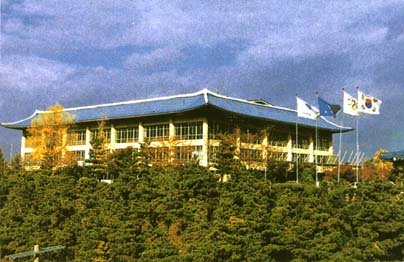
|
This building was initially named Chung An Dojang but it was renamed Kukkiwon. The building was officially opened on November 30, 1972
|
INTERNATIONAL TAEKWON-DO FEDERATION
In 1962 Lee Chong Woo and Uhm Woon Kyu, through a third party invited General Choi Myung Shin, the Chairman of the ROK Military Chief of Staff , to sit as the President Of Tae Soo Do Association. Master Park Jung Tae was the second President. Much to the hostility of Lee and Uhm, General Choi Hong Hi returned to Korea in 1964 after serving in Malaysia as the ambassador of Korea. In 1965 General Choi was again elected by Korean Tae Soo Do members to head the association. He immediately changed the name of Korean Tae Soo Do Association to Korean Taekwon-do Association again . He was the third President. However the new regime had given Lee Chong Woo and Uhm Woon Kyu much power in Korea. In 1966 General Choi was forced to resign from KTA and formed the International Taekwon-do Federation on 22 March, 1966 with 9 countries : Vietnam, Malaysia, Singapore, West Germany, USA, Turkey, the United Arab Republic, Italy and Korea. From 1966 to 1971 taekwon-do spread like wild fire under General Choi and Major Nam Tae Hi . In 1970 itself they introduced taekwon-do to 21 countries.He dispatched a total of 657 Korean instructors around the world.
However things were not plain sailing for General Choi. On October 18, 1971, 6th. Dan Korean taekwon-do instructor Yun Kum Joong, 32, was assasinated in Ipoh, after serving only eleven months in Malaysia.. The case was never solved by the Malaysian police or Interpol. After this incident many Korean instructors disassociated themselves from General Choi Hong Hi and the taekwon-do intrigue. This was a period of low for ITF and General Choi Hong Hi but his determination put ITF on its foot again.. When he passed away of stomache cancer on June 15, 2002 at the age of 84 there were 123 countries with International Taekwon-do Federation.
DEVELOPMENT IN KOREA
Korean Tae Soo Do Association was formed in May 1961. There was no president until 1963 when KTA invited General Choi Myung Shin to sit as president. In 1965 Korean Tae Soo Do was renamed Korean Taekwon-do Association by General Choi.The presidents of KTA were as follows:
1. General Choi Myung Shin 1963
2. Master Park Jung Tae 1964
3. General Choi Hong Hi 1965
4. Master Ro Byung Jik 1966
5. Mr. Kim Yong Chae 1967 - 1970
6. Mr. Kim Un Yong 1971 - 2004
There was not much development in Korea under KTA until 1967 when the Kim Yong Chae took over. He was the 5th. President of KTA . Kim Yong Chae was credited as the man who raised 30,000,000 won to build Chung An Dojang which was eventually named Kukkiwon.

Mr. Kim Un Yong
|








